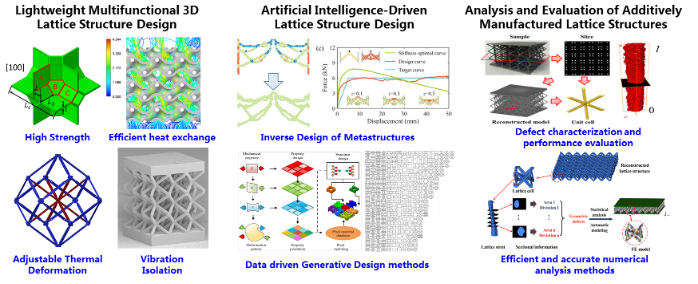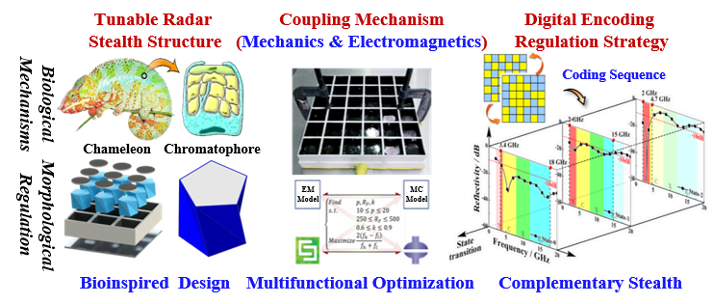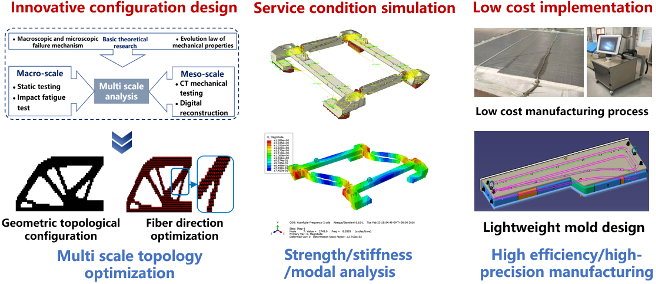The design and application of lightweight multi-fuctional materials and structures is one of important means to improve the structural efficiency of modern equipments. It has attracted wide attention from both the scientific and engineering communities. This research orientation includes: Ultra-lightweight three-dimensional lattice structure, broadband electromagnetic stealth metastructures, high-stability and high-precision structures for space equipment, large sized irregular composite material structures, extreme environments and multi-scale structures, and intelligent bionic robot.
n Design and Manufacturing of Ultra-lightweight Three-dimensional Lattice Structures
In response to the urgent demand for ultra-lightweight and functionally integrated structures in aerospace, modern industry, and other fields, our research explores innovative design methods and deformation control mechanisms for lightweight multifunctional three-dimensional lattice structures. Constitutive models and deformation prediction theories for lattice structures under multi-field coupling are being developed. Characterization evaluation methods and efficient, high-precision mechanical performance analysis methods for additive manufacturing 3D lattice structures are established. Furthermore, artificial intelligence-driven generative design methods for lattice structures are being explored and an integrated design software platform for the additively manufactured lattice structures is being developed. Our research will provide theoretical and technical support required for the design, manufacturing and structural functional integration of equipment structures in aerospace and other fields.

Fig.1 Design and manufacturing of Ultra-lightweight Three-dimensional Lattice
n Design and Fabrication of Broadband Electromagnetic Stealth Metastructures
Multifunctional integration has emerged as a promising lightweight strategy for advanced electromagnetic stealth equipment, especially in low Earth orbit satellites, hypersonic aircraft and special vehicles. Serial investigations focusing on innovative design methodologies and high-precision fabrication techniques have been conducted recently, aiming to elucidate the coupling mechanisms among geometric configuration, structural deformation, mechanical performance, and electromagnetic modulation function. A multifunctional integrated optimization design method has been developed, considering the load-bearing and radar-stealth capabilities. Furthermore, emerging approaches leveraging artificial intelligence, semiconductor materials and micro/nano-scale fabrication technologies are being actively explored. These achievements provide theoretical insights and technological foundations for the broadband design and functional regulation of electromagnetic metastructures.

Fig.2 Bioinspired Tunable Design of Broadband Electromagnetic Stealth Metastructure
n High-Stability Structural Design and High-Precision Digital Geometry Reconstruction for Space Equipment
To meet the critical demand for highly stable structures enabling long-term, high-precision service in advanced systems, this research pioneers a bio-inspired design methodology for high-stability, zero-warpage structures. We have developed optimized sensor deployment strategies, constructed a configuration inversion model leveraging finite strain data, and established a real-time digital geometry reconstruction platform. Furthermore, the team has established an inverse design framework for adaptive structural behavior under thermomechanical actuation, facilitating multi-mode response prediction and mechanical customization. This crystallizes a research paradigm in order to enhance the stability through design, monitoring stability during service, and regulating stability against environmental perturbations—delivering tailored structural solutions for long-term, high-precision operation of aerospace systems in extreme spatial environments.

Fig.3 High-Stability Structural Design and High-Precision Digital Geometry Reconstruction for Equipment
n Design and manufacturing of large-size irregular composite material structures
The use of composite materials as the main load-bearing structural material is the key to improve the lightweight level of industrial equipment. In response to the extreme lightweight requirements of new generation equipment such as hypersonic aircraft, rail vehicles, and aircraft, the research is being conducted on the design and manufacturing of large-size, main load-bearing, multi cavity, and special-shaped composite material structures. The research objective is to establish lightweight optimization design methods for large-size main load-bearing special-shaped composite material structures, develop efficient, high-precision, and low-cost manufacturing processes for lightweight composite material structures, achieve engineering manufacturing of multi cavity main load-bearing special-shaped composite material structures, and provide technical support for the lightweight realization of modern process equipment.

Fig.4 Structural Design and Manufacturing of Large Sized Irregular Composite Materials
n Extreme environment characterization and multi-scale analysis
Regarding the demand to test and evaluate the mechanical properties of materials and structrues at cryogenic temperature ranging from -252 ℃ to -150 ℃ for launching vehicle tank and deep-space exploration vehicles, the mechanical in-situ X-ray computed tomography equipment was built to monitor the damage evolution of materials. The effect of temperature and stress level on internal defect evolution and failure mechanism was studied. Then, the high-fidelity finite element models were generated directly from CT images and the real geometry morphology of microstructrues in materials was introduced in models to predict the mechanical and physical properties. The AI algorithm, 4D in-situ characterization and material twin method were combined to propose novel method to study the material and structure mechanics at extreme environment. Material database and testing platform offer support for the lightweight structure design.

Fig.5 In-situ X-ray CT characterization at cryogenic temperature and leakage behavior analysis method
n Design and Regulation of Multifunctional Biomimetic Robots
The research is targeted at meeting the demand for intelligent robots in fields such as aerospace, transportation, advanced manufacturing, and healthcare. The team has been committed to Investigating the delicate actuation and multi-field response mechanisms of biomimetic robots, exploring the motion control theory of structure/mechanism coupling systems, and establishing lightweight structure/mechanism optimization design methods for biomimetic robots. By developing flexible sensing and inversion technologies for multifield physical information (force, light, electricity, and magnetism) and exploring intelligent reasoning and decision-making systems for biomimetic robots with multimodal, multitask, and multi-domain capabilities, this research aims to generate new platforms, components, and algorithms for biomimetic robots, in order to provide theoretical and technical support for the development of human-machine-environment collaborative robots.

Fig.6 Multifunctional Biomimetic Robots
